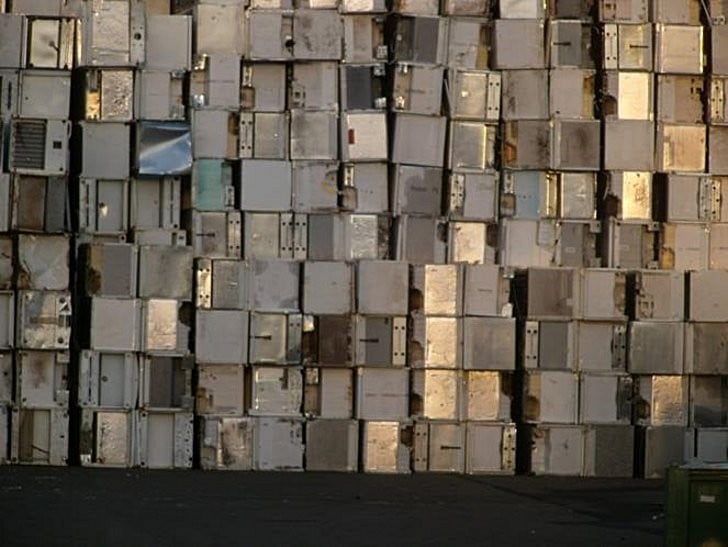RAL CO2OL-PRINT tool makes demanufacturing waste refrigeration appliances more effective and more transparent
Millions of tons of carbon emissions can be prevented through systematic refrigerator demanufacturing

While international climate policymakers debate the implications of the recent US pullout from the Paris climate accord, other key issues to minimizing carbon emissions are not getting the attention they deserve.
From a climate change perspective, around 40% of the end-of-life fridges awaiting recycling in Europe are ticking time bombs. Despite the fact that the Montreal Protocol, which was signed thirty years ago in 1987, successfully banned the production of chlorinated fluorocarbons (CFCs) and their use (for example in refrigeration equipment), a huge number of older pre-ban appliances are still in use in European households.
The large quantity of climatically harmful CFCs still present in refrigeration equipment is not a problem provided these appliances are treated so that the environmentally toxic substances they contain are removed in a systematic and transparent manner that meets stringent environmental quality standards - essentially a definition of the term ‘fridge demanufacturing'. Given the extremely high global warming potential of CFCs, any measures that prevent their emission into the atmosphere will clearly make a major contribution to attaining important climate protection goals. The RAL CO2OL-PRINT tool developed by the RAL Quality Assurance Association for the Demanufacture of Refrigeration Equipment makes demanufacturing waste refrigeration appliances more effective and more transparent.
The facts couldn't be clearer. According to experts in the field, there are still some 25 million CFC-containing and HFC-containing refrigeration appliances in use in the more than 200 million domestic households within the European Union. Failure to recover the refrigerants and blowing agents in these waste refrigeration appliances would result in their release into the environment, which would be equivalent to emitting more than 60 million tons of carbon dioxide into the Earth's atmosphere. To understand what this number means, it is worth realizing that in Germany annual carbon emissions from the entire traffic sector are 160 million metric tons. The situation becomes even clearer when one realizes that the CFCs in a single untreated fridge have a global warning potential of a staggering 2.8 metric tons of CO2, equivalent to the carbon emissions from a medium sized car driving 17,000 kilometres.
This comparison highlights the need to apply the most stringent environmental standards to the treatment of end-of-life refrigeration appliances.
Standardization institutions like RAL and DIN have provided the recycling industry with key regulatory frameworks. The European standard EN 50574:2012 and the associated Technical Specification TS EN50574-2:2014 have been published in Germany as DIN standards that govern the environmentally correct treatment of waste refrigeration equipment. These standards also cover the treatment of appliances manufactured after the Montreal CFC ban. These latter appliances were manufactured with chlorine-free and fluorine-free hydrocarbons, such as R600a (as a replacement refrigerant in the cooling circuit) and pentane (as a substitute blowing agent in the insulating materials). The WEEE Directive and the corresponding national implementing laws require the removal and subsequent collection of refrigerants and blowing agents, the EN standard and its accompanying Technical Specification specify the quantities of refrigerants and blowing agents to be recovered by treatment facilities, irrespective of whether these are CFCs or the more environmentally benign hydrocarbons (HCs).
In order to minimize the carbon footprint from the treatment of end-of-life refrigeration equipment, it is essential that CFC-containing and hydrocarbon-containing appliances are treated jointly within the same demanufacturing plant. Specialist treatment operators not only remove all the CFCs and HCs from the waste appliances, they also recover in pure form the other materials used in the production of the appliances, such as steel, copper, aluminium and plastics. The reintroduction of these secondary raw materials into the production cycle helps to conserve resources and improves the carbon emissions balance sheet of the fridge demanufacturing process, as reuse of materials means lower carbon emission levels compared with new production using virgin raw materials.
The RAL Quality Assurance Association for the Demanufacture of Refrigeration Equipment has introduced its RAL-CO2OL-PRINT tool as a central component of its quality assurance scheme. The key aim of this new tool is to quantify the carbon emissions actually saved by the daily operation of a specific treatment facility. This involves continuously monitoring and measuring the masses of CFCs and HCs actually removed from the cooling circuits and insulation materials of the waste appliances and then translating these figures into CO2 equivalents. The same approach is taken for the metals and plastics also recovered during the treatment process. The carbon emissions associated with the energy consumed when transporting and treating the end-of-life appliances must, of course, also be taken into account. The RAL Quality Assurance Association then combines all of the data into an overall carbon emissions balance sheet that is made available to the demanufacturing facility in the form of a certificate issued monthly or every three or six months.
The RAL CO2OL-PRINT tool is providing a huge boost to process transparency and is helping stakeholders to visualize the major environmental benefits that fridge demanufacturing delivers. By preventing the emissions of millions of tons of CO2 into the earth's atmosphere, professional fridge demanufacturing is playing a key role in achieving our planet's climate protection goals.

